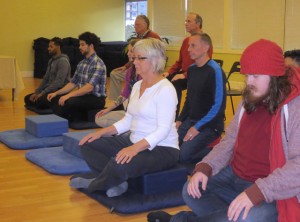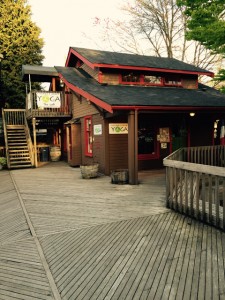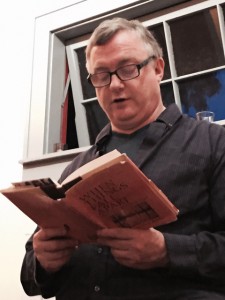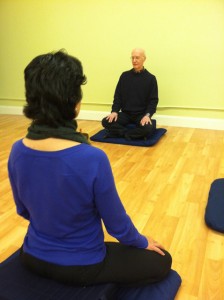Shambhala Community Expanding Offerings to Eastside Technology Communities East of Seattle
Written by: Larry Steele
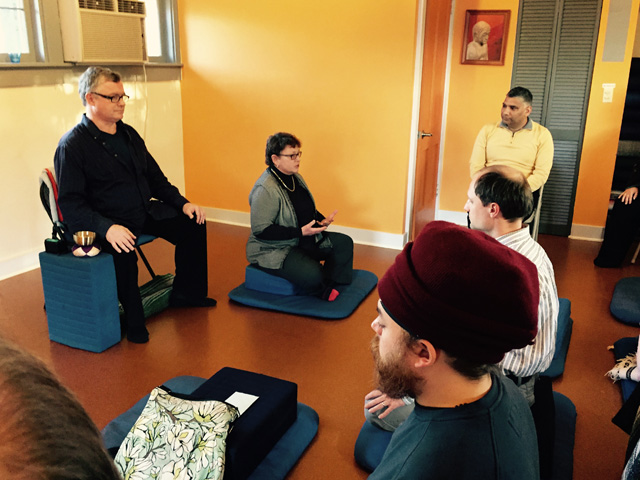
Senior Teacher Mary Bolton begins meditation instruction with the basics, like how to sit on a meditation cushion. Peter Allen is in the umdze, or timekeeper’s, chair.
Photos by: Larry Steele
The Shambhala community’s vibrant new Eastside centers have been growing so strongly, that the Eastside Shambhala group moved into a larger space last November.
This summer Eastside Shambhala offered programs through the summer for the first time, and this fall will begin offering introductory classes from Shambhala’s “In Everyday Life” curriculum. The first likely will start in October.
This summer, the Issaquah Shambhala group was to read a book by Tibetan Buddhist master Dzongsar Jamyang Khyentse, titled “What Makes You Not a Buddhist?”
The two Eastside Shambhala centers, one in Bellevue and the other in Issaquah, now offer weekly meditation instruction, book groups, and talks about meditation in real life, or dharma.
The developments are significant because until recently, few dharma groups and few teachings have been available on the Eastside. The term Eastside refers to a group of smaller tech cities – Bellevue, Kirkland, Redmond and Issaquah – that are immediately east of Seattle, but geographically and psychically separated from Seattle by the 22-mile-long Lake Washington.
“We have a core group of 10 to 12 volunteers, and we see about 100 new people each year,” said Jim Jennings, a senior teacher at Eastside Shambhala Meditation, in Bellevue. “Slow, steady growth has paid off for us, and now we have a bigger, more inviting space for our practice.”
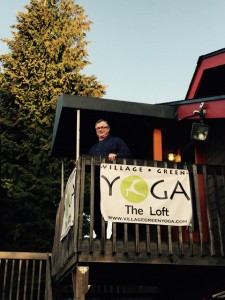
Group Leader Peter Allen on the balcony of the yoga studio where Issaquah Shambhala meets weekly, for meditation instruction and dharma talks.
Issaquah Shambhala Meditation also is growing, meeting in a brightly painted loft in Gilman Village, an Issaquah shopping center.
Shambhala, the meditation community introduced in the west by Chogyam Trungpa Rinpoche and his son and dharma heir, Sakyong Mipham Rinpoche, is vibrant in the Pacific Northwest. Today, a constellation of neighborhood-based meditation groups are clustered around the main Seattle Shambhala Center, including thriving locations in Ballard, West Seattle, Edmonds, and Tacoma, and on the Eastside in Bellevue and Issaquah. Each group is guiding people to experience their own meditation practices.
“People want to learn how to work with their own minds,” said Jennings, who leads the sitting and study group on the Eastside. “The medical community, sports teams, schools, and lots of others are recognizing the value of relaxing. People are learning how to let go of stress, and be aware of how their minds respond to the world around them. That’s where we begin.”
Eastside Shambhala Meditation meets at 6:30 p.m. Tuesdays, at the Dream Clinic, 15436 Bel-Red Road, in Redmond. Issaquah Shambhala Meditation meets at 7 p.m., Wednesdays, at the Village Green Yoga Studio, 317 NW Gillman Village Boulevard, Suite 2, in Issaquah. Visit Seattle Shambhala for details.
“Through our meditation we develop the possibility of meeting our everyday activities with awareness, peace, wisdom, compassion and a sense of humor,” said Jennings. “With practice, we can learn to appreciate ourselves and our human experiences, free from self-aggression. Difficult emotions and the challenges of life can be met with gentleness, steadiness, and humor.”
At the Eastside and Issaquah groups, evenings begin with basic meditation instruction and a short period of silent meditation. Mary Bolton, a meditation teacher at Issaquah Shambhala, recently began the instruction with the basics, explaining how to sit on a meditation cushion, the importance of good posture, and where to focus your eyes.
“We sit in a posture that is relaxed, but uplifted and dignified, because where the body goes, the mind goes,” Bolton said. “By sitting quietly, we become familiar with the thoughts and feelings that arise in our minds. We become familiar with ourselves.”
Bolton also gave the evening’s dharma talk on the topic of contentment.
“Our minds tend to bubble with thoughts and opinions like a pot of boiling water,” she said. “Things constantly rise up in our minds, dwell there for a while, then fade away. Meditation helps us learn to see the interplay of thoughts and feelings in our minds without becoming stuck, or attached, to them. That’s contentment.”
After meditating together the groups study and discuss readings from a selected book. Peter Allen, a leader at Issaquah Shambhala, recently read chapters from “Things Fall Apart,” by Pema Chodron, the widely popular Buddhist teacher, author, and nun.
Shambhala offers a series of classes and retreats, beginning with the “Everyday Life” series, which are offered regularly at Shambhala centers around the Northwest. The Seattle Shambhala web site includes a program calendar.
Classes are designed to strengthen meditation practice, and to clarify both mindfulness teachings and the classical teachings of Buddhism. Some meditators continue to deepen their practice with week-long or month-long retreats at residential centers, such as the Shambhala Mountain Center in the Colorado Rocky Mountains.
A distinctive quality of Shambhala teachings is that they can be expressed through existing cultural norms, making use of our personal experience as part of the meditative practice.
“It is an interesting dharma that the people in our community come from so many different places around the world, and from so many age groups,” said Jennings. “You can’t have a fixed idea about how anyone’s experience of meditation will turn out. It’s about being present and aware of every moment. It’s about providing what is needed. It’s about providing what is helpful.”
Creating an enlightened society is the essential specialty of Shambhala Buddhism. It means joining the calm awareness of meditative practice with an effort to touch the heart of human society. It’s a complex task.
Tom Gaylord, director of Shambhala Seattle, foresees more and more people in the Puget Sound region discovering the energy of their own awareness.
“We are learning how to create and sustain our society,” Gaylord said. “We want to give people the opportunity to learn about meditation, and to continually deepen their practice of living every day.”

